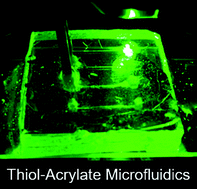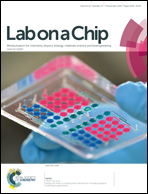Microfluidics using a thiol–acrylate resin for fluorescence-based pathogen detection assays†
Abstract
We demonstrate thiol–acrylate microfluidics prepared via soft lithography for single-step protein immobilization and fluorescence-based pathogen detection. Such microfluidics are formed via room temperature curing, and bonded without oxygen plasma. The background fluorescence of the resin was found to be similar to PDMS for several filter sets. We also show that thiol–acrylate devices are able to bond to gold-coated surfaces, which allows for integration with microfabricated sensors.


 Please wait while we load your content...
Please wait while we load your content...